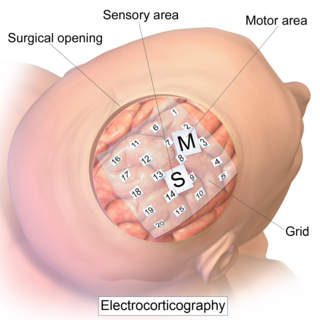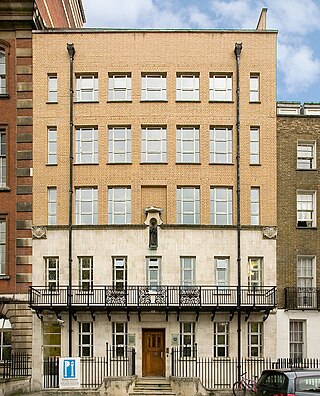Related Research Articles

Magnetoencephalography (MEG) is a functional neuroimaging technique for mapping brain activity by recording magnetic fields produced by electrical currents occurring naturally in the brain, using very sensitive magnetometers. Arrays of SQUIDs are currently the most common magnetometer, while the SERF magnetometer is being investigated for future machines. Applications of MEG include basic research into perceptual and cognitive brain processes, localizing regions affected by pathology before surgical removal, determining the function of various parts of the brain, and neurofeedback. This can be applied in a clinical setting to find locations of abnormalities as well as in an experimental setting to simply measure brain activity.

Functional magnetic resonance imaging or functional MRI (fMRI) measures brain activity by detecting changes associated with blood flow. This technique relies on the fact that cerebral blood flow and neuronal activation are coupled. When an area of the brain is in use, blood flow to that region also increases.

Functional neuroimaging is the use of neuroimaging technology to measure an aspect of brain function, often with a view to understanding the relationship between activity in certain brain areas and specific mental functions. It is primarily used as a research tool in cognitive neuroscience, cognitive psychology, neuropsychology, and social neuroscience.
Neuroimaging is a medical technique that allows doctors and researchers to take pictures of the inner workings of the body or brain of a patient. It can show areas with heightened activity, areas with high or low blood flow, the structure of the patients brain/body, as well as certain abnormalities. Neuroimaging is most often used to find the specific location of certain diseases or birth defects such as tumors, cancers, or clogged arteries. Neuroimaging first came about as a medical technique in the 1880's with the invention of the human circulation balance and has since lead to other inventions such as the x-ray, air ventriculography, cerebral angiography, PET/SPECT scans, magnetoencephalography, and xenon CT scanning.

Neuroimaging is the use of quantitative (computational) techniques to study the structure and function of the central nervous system, developed as an objective way of scientifically studying the healthy human brain in a non-invasive manner. Increasingly it is also being used for quantitative research studies of brain disease and psychiatric illness. Neuroimaging is highly multidisciplinary involving neuroscience, computer science, psychology and statistics, and is not a medical specialty. Neuroimaging is sometimes confused with neuroradiology.

Electrocorticography (ECoG), a type of intracranial electroencephalography (iEEG), is a type of electrophysiological monitoring that uses electrodes placed directly on the exposed surface of the brain to record electrical activity from the cerebral cortex. In contrast, conventional electroencephalography (EEG) electrodes monitor this activity from outside the skull. ECoG may be performed either in the operating room during surgery or outside of surgery. Because a craniotomy is required to implant the electrode grid, ECoG is an invasive procedure.
EEG-fMRI is a multimodal neuroimaging technique whereby EEG and fMRI data are recorded synchronously for the study of electrical brain activity in correlation with haemodynamic changes in brain during the electrical activity, be it normal function or associated with disorders.
Kenneth Kin Man Kwong is a Hong Kong-born American nuclear physicist. He is a pioneer in human brain imaging. He received his bachelor's degree in Political Science in 1972 from the University of California, Berkeley. He went on to receive his Ph.D. in physics from the University of California, Riverside studying photon-photon collision interactions.

The Wellcome Centre for Human Neuroimaging at University College London is a world-leading interdisciplinary centre for neuroimaging research based in London, United Kingdom. Researchers at the Centre use expertise to investigate how the human brain generates behaviour, thoughts and feelings and how to use this knowledge to help patients with neurological and psychiatric disorders. Human neuroimaging allows scientists to non-invasively investigate the brain structure and functions including Action, Decision Making, Emotion, Hearing, Language, Memory, Navigation, Seeing, Self awareness, Social Behaviour and the Bayesian Brain
Integrative neuroscience is the study of neuroscience that works to unify functional organization data to better understand complex structures and behaviors. The relationship between structure and function, and how the regions and functions connect to each other. Different parts of the brain carrying out different tasks, interconnecting to come together allowing complex behavior. Integrative neuroscience works to fill gaps in knowledge that can largely be accomplished with data sharing, to create understanding of systems, currently being applied to simulation neuroscience: Computer Modeling of the brain that integrates functional groups together.
Robert Turner is a British neuroscientist, physicist, and social anthropologist. He has been a director and professor at the Max Planck Institute for Human Cognitive and Brain Sciences in Leipzig, Germany, and is an internationally recognized expert in brain physics and magnetic resonance imaging (MRI). Coils inside every MRI scanner owe their shape to his ideas.
The Human Connectome Project (HCP) is a five-year project sponsored by sixteen components of the National Institutes of Health, split between two consortia of research institutions. The project was launched in July 2009 as the first of three Grand Challenges of the NIH's Blueprint for Neuroscience Research. On September 15, 2010, the NIH announced that it would award two grants: $30 million over five years to a consortium led by Washington University in St. Louis and the University of Minnesota, with strong contributions from University of Oxford (FMRIB) and $8.5 million over three years to a consortium led by Harvard University, Massachusetts General Hospital and the University of California Los Angeles.
Anders Martin Dale is a prominent neuroscientist and professor of radiology, neurosciences, psychiatry, and cognitive science at the University of California, San Diego (UCSD), and is one of the world's leading developers of sophisticated computational neuroimaging techniques. He is the founding Director of the Center for Multimodal Imaging Genetics (CMIG) at UCSD.
Arno Villringer is a Director at the Department of Neurology at the Max Planck Institute for Human Cognitive and Brain Sciences in Leipzig, Germany; Director of the Department of Cognitive Neurology at University of Leipzig Medical Center; and Academic Director of the Berlin School of Mind and Brain and the Mind&Brain Institute, Berlin. He holds a full professorship at University of Leipzig and an honorary professorship at Charité, Humboldt-Universität zu Berlin. From July 2022 to June 2025 he is the Chairperson of the Human Sciences Section of the Max Planck Society.

Resting state fMRI is a method of functional magnetic resonance imaging (fMRI) that is used in brain mapping to evaluate regional interactions that occur in a resting or task-negative state, when an explicit task is not being performed. A number of resting-state brain networks have been identified, one of which is the default mode network. These brain networks are observed through changes in blood flow in the brain which creates what is referred to as a blood-oxygen-level dependent (BOLD) signal that can be measured using fMRI.
Peter T. Fox is a neuroimaging researcher and neurologist at the University of Texas Health Science Center at San Antonio. He is a professor in the Department of Radiology with joint appointments in Radiology, Medicine, and Psychiatry. He is the founding director of the Research Imaging Institute.
The following outline is provided as an overview of and topical guide to brain mapping:
Bruce Rosen is an American physicist and radiologist and a leading expert in the area of functional neuroimaging. His research for the past 30 years has focused on the development and application of physiological and functional nuclear magnetic resonance techniques, as well as new approaches to combine functional magnetic resonance imaging (fMRI) data with information from other modalities such as positron emission tomography (PET), magnetoencephalography (MEG) and noninvasive optical imaging. The techniques his group has developed to measure physiological and metabolic changes associated with brain activation and cerebrovascular insult are used by research centers and hospitals throughout the world.
Patrick Lee Purdon is an American biomedical engineer whose research focuses on neuroscience, neuroengineering, and clinical applications. He holds the Nathaniel M. Sims Endowed Chair in Anesthesia Innovation and Bioengineering at Massachusetts General Hospital and is an associate professor of anaesthesia at Harvard Medical School. Purdon received his Ph.D. in biomedical engineering from Massachusetts Institute of Technology in 2005. His research in neuroengineering encompasses the mechanisms of anesthesia, Alzheimer’s disease and brain health, anesthesia and the developing brain, neural signal processing, and the development of novel technologies for brain monitoring. He has published over 90 peer-reviewed publications, is an inventor on 16 pending patents, and is a Fellow of the American Institute for Medical and Biological Engineering. Purdon has won many awards, including the prestigious National Institutes of Health Director’s New Innovator Award, and his work has been covered in the popular media, including programs on Radiolab and NPR.
References
- ↑ Belliveau JW, Kennedy DN, McKinstry RC, Buchbinder BR, Weisskoff RM, Cohen MS, Vevea JM, Brady TJ, Rosen BR (1991). "Functional mapping of the human visual cortex by magnetic resonance imaging". Science . 254 (5032): 716–719. Bibcode:1991Sci...254..716B. doi:10.1126/science.1948051. PMID 1948051.
- ↑ KK Kwong, JW Belliveau, DA Chesler, IE Goldberg, RM Weisskoff, BP Poncelet, DN Kennedy, BE Hoppel, MS Cohen, R Turner, H Cheng, TJ Brady, and BR Rosen (1992). "Dynamic Magnetic Resonance Imaging of Human Brain Activity During Primary Sensory Stimulation". PNAS . 89 (12): 5951–55. Bibcode:1992PNAS...89.5675K. doi: 10.1073/pnas.89.12.5675 . PMC 49355 . PMID 1608978.
{{cite journal}}: CS1 maint: multiple names: authors list (link) - ↑ S Ogawa, DW Tank, R Menon, JM Ellerman, SG Kim, H Merkle, K Ugurbil (1992). "Intrinsic signal changes accompanying sensory stimulation: Functional brain mapping with magnetic resonance imaging". PNAS . 89 (13): 5675–79. Bibcode:1992PNAS...89.5951O. doi: 10.1073/pnas.89.13.5951 . PMC 402116 . PMID 1631079.
{{cite journal}}: CS1 maint: multiple names: authors list (link) - ↑ [RI Goldman, JM Stern, J Engel, Jr., MS Cohen (2002). "Simultaneous EEG and fMRI of the alpha rhythm". NeuroReport . 13 (18): 2487–92. doi: 10.1097/01.wnr.0000047685.08940.d0 . PMC 3351136 . PMID 12499854.
{{cite journal}}: CS1 maint: multiple names: authors list (link) - ↑ Cohen, Mark S; Kosslyn, Stephen M; Breiter, Hans C; DiGirolamo, GJ; Thompson, William; Bookheimer, Susan Y; Belliveau, John W; Rosen, Bruce R (1996). "Changes in Cortical Activity During Mental Rotation: A mapping study using functional magnetic resonance imaging". Brain. 119: 89–100. doi: 10.1093/brain/119.1.89 . PMID 8624697.
- ↑ Vaughn, Donald A; Savjani, RR; Cohen, Mark S; Eagleman, David M (2018). "Empathic Neural Responses Predict Group Allegiance". Frontiers in Human Neuroscience. 12: 302. doi: 10.3389/fnhum.2018.00302 . PMC 6079240 . PMID 30108493.
- ↑ Harris, Sam; Sheth, Sameer A; Cohen, Mark S (2008). "Functional neuroimaging of belief, disbelief, and uncertainty". Annals of Neurology. 63 (2): 141–147. doi:10.1002/ana.21301. PMID 18072236. S2CID 17335600.